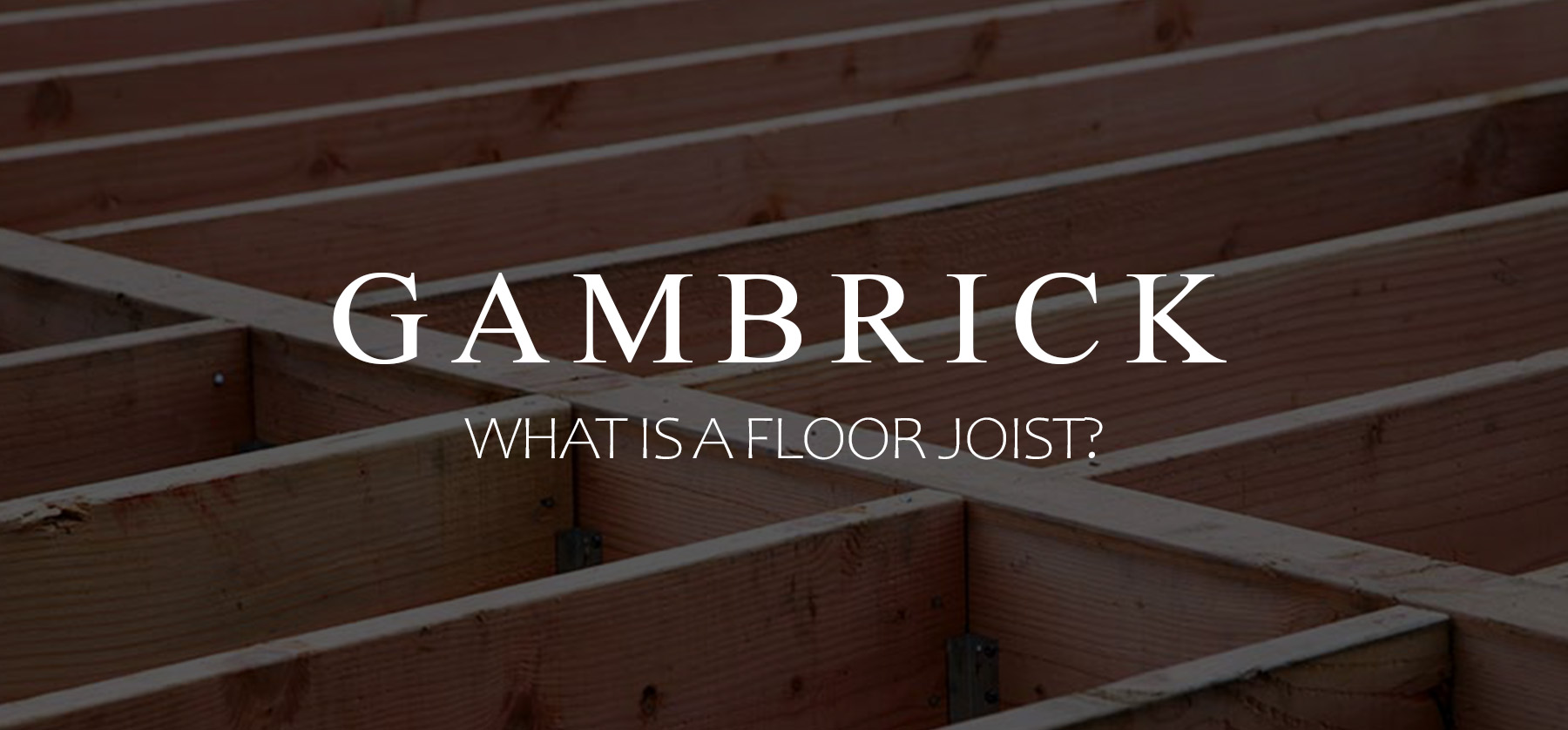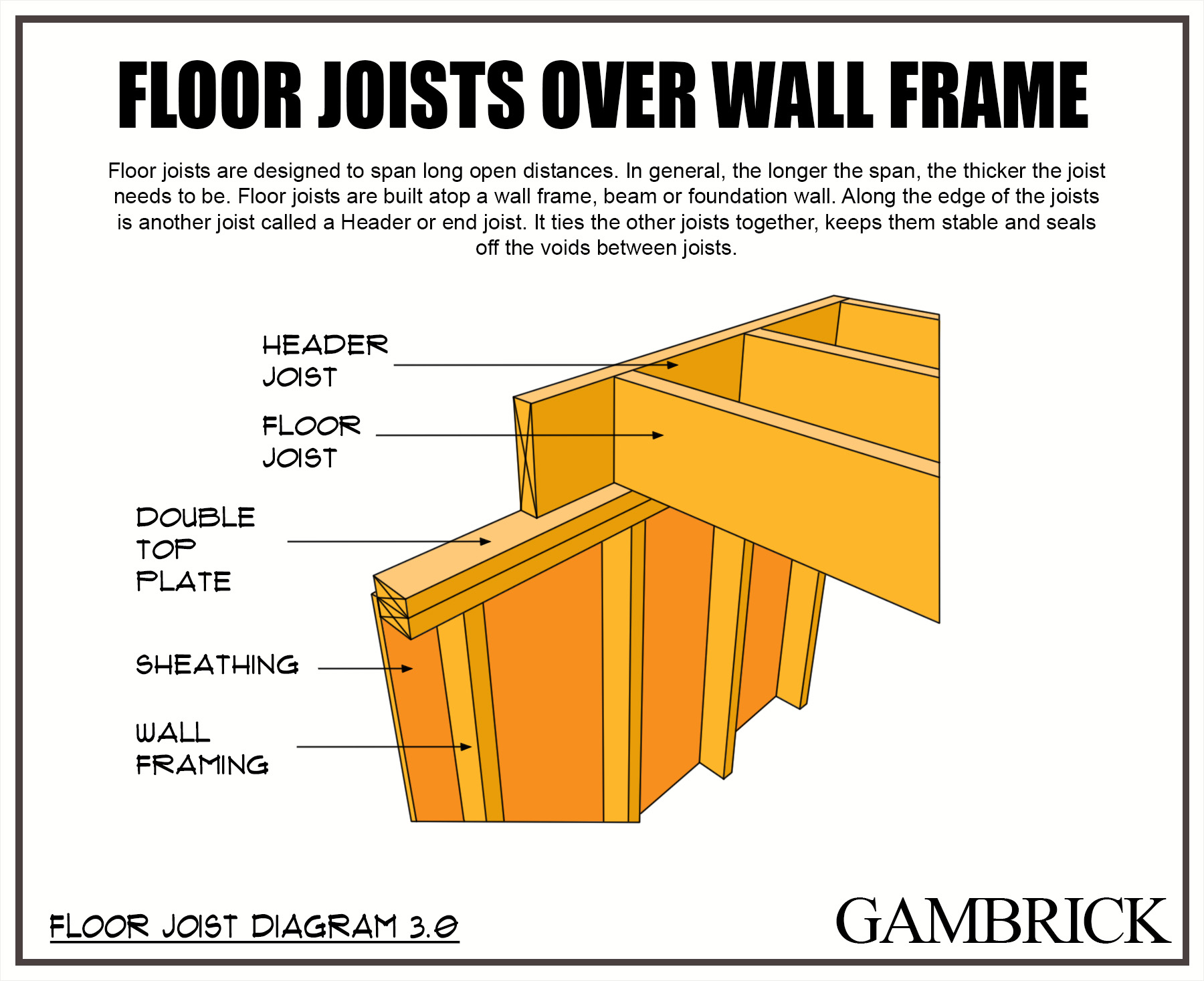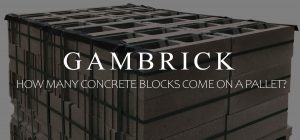What Is A Floor Joist?
A Floor Joist is a horizontal structural framing member used to span an open area. They sit atop a beam, wall frame or foundation at both ends which supports their weight. Any weight placed atop the joists is transferred down onto the vertical members that support it. All the weight inside a room, including the walls, flooring, furniture and people, is ultimately transferred all the way down to the structure’s foundation and footings. Joists are sized and spaced by a structural engineer, architect or the joist manufacturer based on the distance of the span and the weight they must support.
Floor joists come in a few different forms, the most common being solid timber, I-joists and open-web trusses. In residential construction, they’re usually made out of either solid timber or engineered wood. However, in commercial construction floor joists are more commonly made out of metal.
Home floor joists are large wood framing members which rest on top of a load bearing beam, framed wall or foundation. They’re all exactly the same size and evenly spaced. Once installed, joists are covered by a plywood sub-floor and eventually finished flooring. The walls and roof above are built directly on top of the floor joists.
In most cases, residential floor joists are spaced 16 inches apart on center. However this can vary depending on building codes and the requirements of the structure being built.
Floor joists help support the load of a structure. When weight is placed on the floor of a structure, the bottom of the joists are placed under tension while the top of the joists are being compressed. This balance between tension and compression helps distribute the load across the span more evenly.
Components Of A Floor Frame
When it comes to building a structure, whether it’s a house or a commercial building, structural support is crucial for ensuring its stability and longevity. One of the key structural components that provides such support are the floor joists. A floor joist is a horizontal member that spans the distance between two load-bearing supports such as walls, columns, foundations, or beams. They provide a solid base for the sub-floor and finished flooring material.
The floor joist system helps distribute the weight of the building, its contents and occupants evenly across the foundation. They help prevent sagging or unevenness in the floor. But they’re only one component of a structure’s floor frame.
- Floor joists: Large framing members that span open areas between load bearing walls, beams, columns or foundation walls. They’re all the same size and evenly spaced. A sub-floor is installed atop the joists and eventually the finished flooring.
- Blocking: Blocking, or bridging, is made up of smaller wood pieces installed between joists in the opposite direction the joist is running. They provide lateral support and stability.
- Header joists: A header, or rim joist, is installed at the butt end of the joists. It provides lateral stability and closes the void between joists.
- Sill plate: When floor joists are built atop a foundation wall, the rest on a sill plate. Sill plates are usually made from treated wood.
- Support beam: A large wood or steel beam used to support the load above, in this case the floor joists. When joists aren’t long enough to span the distance between foundation walls, they typically rest on either a beam or an interior wall.
Floor joists can be made from a variety of materials including wood, steel, or concrete.
Types Of Floor Joists
Floor joists can be made from a variety of materials, including wood, steel, or concrete. Each material has its own set of advantages and disadvantages. The floor joists of a home or building are designed by a structural engineer or architect. They’re sized and spaced according to the spans they have to cover and the weight they must support. Other factors such as cost, availability, and fire resistance are also considered.
There are several sizes and types of floor joists used to build homes. The most common material is solid timber or engineered wood.
- Solid Timber floor joists come in sizes 2 × 8, 2×10, 2 × 12.
- Engineered wood is usually taller and comes in 3.5 x 12, 3.5 x 14 or 3.5 x 16.
Solid Lumber Joists
Solid wooden joists are the most common type of floor joists used to build homes. They’re often made from softwood timber, such as spruce, pine, or fir.
These joists can be standard dimensional lumber, typically 2 x 8, 2 x 10, or 2 x 12 inches. Wooden joists are affordable, widely available, and easy to work with, but they’re not as strong as many other types of joists.
Solid lumber joists are usually made from old-growth trees. Their span distance is affected by species, board size, spacing, and deflection.
Solid timber joists are still used to build homes, but much less than they used to be. These days most homes are using engineered joists instead.
Pros
- Lasts longer during a fire than some other types of joists
- Less expensive than engineered lumber or steel
- Great for smaller spans and lighter loads
- Easy to buy because they’re stocked at every lumber yard
Cons
- Limited span distance compared to other materials
- Large sizes can be heavy and hard to work with
- Can warp and twist easily
- Flexes more than engineered wood or steel
I-Joists a.k.a. TJI Joists
I-joists are a type of engineered wood joist that have an “I” shape. This makes them stronger and more uniform than traditional lumber joists. They’re manufactured in a factory out of different pieces of wood. The tops and bottoms are typically made of a solid wood 2 x 4 or a laminated veneer. The center support is usually made from plywood or oriented strand board (OSB).
Because the top and bottom section of the I-joist is made from a 2 x 4, it’s wider than solid timber. This makes the joists more stable and less likely to tip over.
Most engineered I-joists are a2 inches taller than solid timber. For example, common sizes for timber joists are 2 x 8, 2 x 10 and 2 x 12. Common sizes for TJI joists are 3.5 x 10, 3.5 x 14 and 3.6 x 16.
Even though TJI joists are wider and taller, they’re lighter and stiffer. They don’t flex, warp or bend as much and are easier to work with.
Engineered joists are stronger than solid timber joists and can span greater distances safely.
Pros
- Longer spans than solid timber joists
- Lighter and less likely to bend, twist or warp
Cons
- Fail faster in a fire
- Cost more
- Harder to get and generally need special ordering
I-joists are lightweight, easy to install, and can span long distances, making them a popular choice for modern construction projects.
Open-Web Floor Trusses
Open-web floor trusses are similar to TJI joists except the center section has open space instead of solid plywood or OSB. Sections of wood or metal are typically positioned in a triangular shape to support the floor loads above. Many builders prefer open trusses vs solid timer or engineered wood because they don’t have to drill holes for electrical wiring, ducts or piping.
Pros
- Can span longer distances than engineered wood and solid timber
- Makes it easier to install HVAC, plumbing, and electrical without drilling or cutting
- Light weight
- Stable
Cons
- Custom built in specific lengths that can’t be trimmed
- Must be special ordered
- Higher cost than other types of floor joists
Open Web joists can also be made out of steel. These are more common in commercial construction than in homes. Open-web steel joists are a type of steel joist that has an open web design. The open design makes it easier to install HVAC, electrical, and plumbing systems. They’re lightweight, easy to install, and can be customized to fit specific building needs.
If you look up in most warehouses like Home Depot, Lowes and Costco, you’ll see open steel trusses supporting the roof.
Steel Joists
Steel joists are often used in commercial buildings or structures where extremely heavy loads need to be supported. They can span longer distances than solid wood, engineered wood and open-web joists.
Steel joists are typically prefabricated off-site and then bolted or welded together on-site. They’re extremely strong, durable and very heavy. Typically steel joists are lifted and positioned by machine and not by hand. They’re more expensive than other types of floor joists and require specialized skill to install.
Steel joists are typically welded or bolted in place rather than using nails or screws.
Concrete Joists
Concrete joists, also known as pre-stressed concrete joists, are made by casting concrete into a shape that can support the loads of a building. They have a steel rebar core which gives the concrete strength, stability and flexibility.
In some cases concrete joists can span even longer distances than steel joists. They’re strong, fire-resistant, and have a long lifespan, but they can be expensive and extremely heavy.
Concrete joists are typically used in commercial and industrial construction and not for residential homes.
Joist Span
One of the main considerations when choosing the right material and size floor joist is the span. Floor joists are installed over large open areas with a support on both ends. The support is typically a wall frame, beam or foundation wall. The greater the span, the stronger the material needs to be and the bigger the joist.
When building a new home or building, an engineer or architect will design the joists. They choose the material, size and spread of the joists based on the distances they must span and the weight they’ll need to support.
As a rule, the larger the span, the larger the joists that are used. However, building codes, weight, flex, price and fire resistance are also considered when choosing a floor joist.
There are no standard joist sizes or materials that are right for every project. Many factors should be considered when determining the correct joist size and material for the job.
Traditionally, solid timber joists were the most common used in residential construction. However, these days builders use more engineered TJI joists or open-web trusses.
What Type Of Wood Is Best For A Floor Joist?
The best types of wood used to make solid timber floor joists are Southern Yellow Pine and Douglas Fir. They’re strong and durable with good bending strength. Not all wood has the same strength or flexibility. The bending strength of a wood is the load the lumber can withstand perpendicular to the grain. This is usually measured in low, medium, and high bending strength. This is important to consider when choosing a floor joist because you don’t want too much bounce in the floor.
A floor joist with too much flax can cause hard finished flooring, like tile or hardwood, to crack or split.
Stronger types of wood can span longer distances without needing additional support.
Lumber Grade
Another factor to consider when selecting a wood floor joist is the lumber grade. The grade is determined by the amount of knots and other defects that are found. Higher grade lumber has fewer defects which makes them stronger than lower grade wood. However, higher grade lumber also costs more.
The most common lumber grade used for floor joists is #2. It has more knots and defects than higher grades, but it’s still very strong and durable.
Lumber Width
The width or a joists also effects how long a distance it can span. Typical solid lumber joists are just 1.5 inches wide, but TJI joists are 3.5 inches wide on the top and bottom with a vertical sheet of plywood in the middle.This design is what gives the TJI its I-shape.
The strength of a joist board is more effected by its top-to-bottom height than it’s width as long as its at least 1.5 inches wide. I would not recommend using wood for a floor joist that’s under the standard 1.5 inch nominal lumber board width.
Load Capacity
Load capacity is very important to consider when selecting a floor joist. The primary job of a joist is to support the weight placed atop it. When building a home, this is done by a structural engineer or an architect.
There are two types of weight loads a floor must bear: live and dead.
Live Loads: The live load is the weight of things placed on the floor that aren’t part of the structure. This can include furniture and people. Usually the live load is based on how many pounds per square foot the joists must support. According to the International Residential Code, non-sleeping rooms must support a minimum live load of 40 pounds per square foot while sleeping rooms must support 30 pounds per square foot.
Dead Loads: The weight of the floor structure and anything permanently attached to the joists is part of its dead load. Dead load is calculated by adding up any and all materials that make up the floor. This includes the sub-floor and finished flooring.
Deflection: Deflection is the bend or “sag” in a floor caused by the load placed atop it. It’s best to choose a joist that doesn’t flex much because movement can crack wood flooring and tile. The maximum allowable deflection is usually a fraction of the span length (L) in inches. For floor joists, dead and live loads shouldn’t exceed L/240 which is based on the 2012 International Building Code (IBC), Section 1604.3.
How Do I Know What Size Floor Joist I Need?
A simple way to know what size floor joist you need is half the span plus 2. For example, if the room has a 20 feet span, half that distance plus 2 means you need a 12 inch deep joist. However keep in mind that this is for solid timber joists only and is just a basic rule of thumb. Floor joists should be designed by a structural engineer or architect.
Most solid timber floor joists are spaced 16 inches on center.
If you’re using TJI or similar engineered I-joists, the company will usually design the floor joist system for you. If you email them your blueprints, they’ll determine the correct size joist you need and will provide a layout for each joist.
What Are Floor Joists?
Floor joists are horizontal structural elements that provide support for a building’s flooring system. They’re typically installed parallel to each other and spaced apart at regular intervals. The end of each joist rests on load-bearing supports such as walls, beams, or columns. Floor joists come in a variety of materials, including wood, steel, and concrete.
- Wooden floor joists are the most common type and are often made from softwood lumber, such as pine or fir. Solid lumber joists are usually 1.5 inch wide standard dimensional lumber, typically 2 x 8, 2 x 10, or 2 x 12 inches. But they can be engineered wood joists (EWJs), which are made from layers of wood veneers or strands bonded together with adhesives and formed into various shapes and sizes. EWJs are often lighter, stronger, and more uniform in size and strength than traditional lumber joists.
- Steel floor joists are typically used in commercial buildings or structures where heavy loads need to be supported. Steel joists can span longer distances than wooden joists and are often prefabricated off-site and then bolted or welded together on-site.
- Concrete joists, also known as prestressed concrete joists, are a floor joist used in commercial and industrial construction. They’re made by casting concrete into a shape that can support the loads of a building with a steel rebar frame inside.
No matter which material is used, floor joists must be designed and installed according to building codes and regulations, which specify factors such as the load-bearing capacity, span, and spacing requirements for a given building type and location.
Proper installation is crucial for ensuring the structural integrity of the flooring system and structure.
Floor joists should be designed by an architect, structural engineer or the manufacturer of the engineered joist.
The Purpose Of Floor Joists
Floor joists provide structural support for a building’s flooring system. The flooring system includes the subfloor, underlayment, and finished floor materials such as hardwood, tile, or carpet. Without proper support from floor joists, the flooring system can sag or become uneven, leading to safety hazards and expensive repairs.
Floor joists help distribute the weight of a building and its occupants evenly across the foundation. They help prevent excessive stress on any one area of the structure. This design ensures the structure will remain stable and level over time, which is essential for both safety and functionality.
The load-bearing capacity of the floor joists must be designed to meet the specific requirements of the building. The design should consider factors such as the size and weight of the building, the intended use of the space, and local building codes and regulations.
In addition to providing structural support, floor joists also help prevent sound transmission between floors. By separating the flooring materials from the rest of the building structure, floor joists help to reduce the transmission of sound and vibrations between floors. This can be important in multi-story buildings or buildings that house sensitive equipment.
Overall, the purpose of floor joists is to provide a stable, level, and safe foundation for a building’s flooring system. Without proper floor joists, the entire structure could be compromised, leading to costly repairs, safety hazards, and potentially even structural failure. Therefore, it’s essential to ensure that the floor joists are designed and installed correctly, and that they are maintained and inspected regularly to ensure their continued stability and safety.
Summary: What Is A Floor Joist?
A Floor Joist is a horizontal structural framing member used to span an open area. They sit atop a beam, wall frame or foundation at both ends which supports their weight. Any weight placed atop the joists is transferred down onto the vertical members that support it. All the weight inside a room, including the walls, flooring, furniture and people, is ultimately transferred all the way down to the structure’s foundation and footings. Joists are sized and spaced by a structural engineer, architect or the joist manufacturer based on the distance of the span and the weight they must support.
Floor joists come in a few different forms, the most common being solid timber, I-joists and open-web trusses. In residential construction, they’re usually made out of either solid timber or engineered wood. However, in commercial construction floor joists are more commonly made out of metal.
Home floor joists are large wood framing members which rest on top of a load bearing beam, framed wall or foundation. They’re all exactly the same size and evenly spaced. Once installed, joists are covered by a plywood sub-floor and eventually finished flooring. The walls and roof above are built directly on top of the floor joists.
In most cases, residential floor joists are spaced 16 inches apart on center. However this can vary depending on building codes and the requirements of the structure being built.
Floor joists help support the load of a structure. When weight is placed on the floor of a structure, the bottom of the joists are placed under tension while the top of the joists are being compressed. This balance between tension and compression helps distribute the load across the span more evenly.
If you have any questions or comments about floor joists, email any time.
























